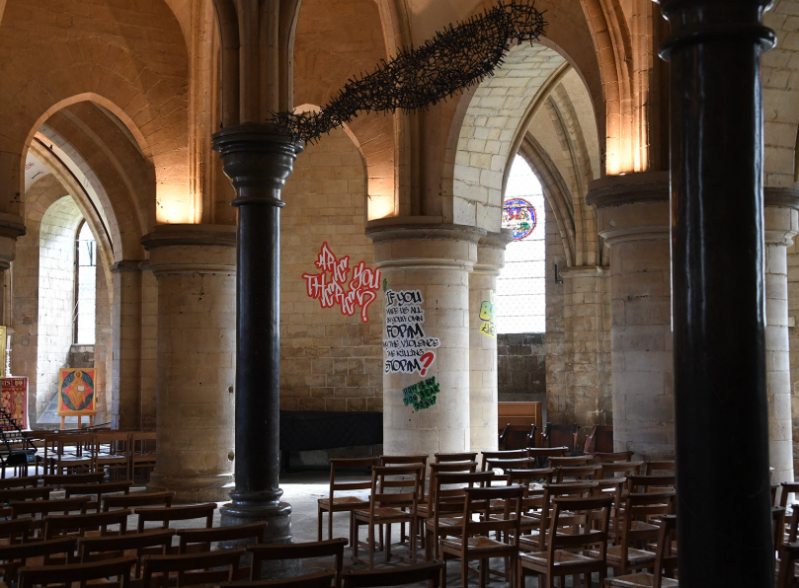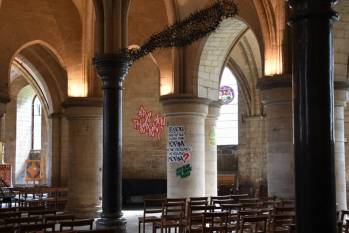
A new graffiti-style art installation inside Canterbury Cathedral where visitors are invited to question God has ignited controversy — drawing criticism from U.S. Vice President J.D. Vance, billionaire Elon Musk, as well as U.K. and international church leaders who say the project undermines the sacredness of one of Christianity’s most historic sites.
The centuries-old cathedral, a central site of Anglican worship and pilgrimage for more than a millennium, unveiled “Hear Us” — an installation combining poetry and graffiti developed in collaboration with marginalized communities. Created by poet Alex Vellis, who identifies as agender and uses "they/them" pronouns, and curator Jacquiline Creswell, the project invites participants to write what they would ask God, with their handwritten questions now displayed in graffiti lettering across the cathedral’s ancient stone walls and floors.
Organizers say the exhibition seeks to give voice to the unheard and provoke spiritual reflection. But critics argue that using graffiti within the 1,400-year-old cathedral desecrates a sacred space, reflecting what Musk called “anti-Western propaganda” and what Vance described as a cultural “self-sabotage” of beauty and tradition.
The cathedral acknowledged in its press release that the installation, which opens Oct. 17 and runs until Jan. 18, has “split public opinion.” It said visitors have reported “visceral reactions” to the vivid artwork and the theological questions it raises, such as “Are you there?”, “Why did you create hate when love is more powerful?” and “Does everything have a soul?”
“There is a rawness which is magnified by the graffiti style which is disruptive,” said the Very Rev. David Monteith, Dean of Canterbury. “There is also an authenticity in what is said because it is unfiltered and not tidied up or sanitised.”
Poet Alex Vellis said the core of the project was about community, voice, and change. “Language is the people who speak it, and graffiti is the language of the unheard,” Vellis said. “By temporarily graffitiing the inside of Canterbury Cathedral, we join a chorus of the forgotten, the lost, and the wondrous.”
Curator Jacquiline Creswell described the installation as a form of theological engagement rather than provocation. “Within a theological context, posing a question to God is viewed as a form of prayer, meditation, or contemplation,” she said. “By reaching out to the Divine with personal inquiries, individuals may find comfort, clarity, and direction amidst life’s uncertainties.”
According to the cathedral, the “striking contrasts” between the historic Gothic architecture and contemporary graffiti art were intended to demonstrate that “spirituality is not static, but an evolving journey.”
International and domestic criticism
One of the most prominent international reactions came from U.S. Vice President J.D. Vance, who criticized the installation in a post on X (formerly Twitter). “It is weird to me that these people don’t see the irony of honoring ‘marginalized communities’ by making a beautiful historical building really ugly,” he wrote.
Elon Musk, owner of Tesla and X, also condemned the project, suggesting it reflected a broader cultural decline. “Relentless anti-Western propaganda has made so many people in the West want to suicide their own culture,” he posted, adding, “Unfortunately, propaganda works.”
Reporting by Christian Today in the U.K. highlighted that many evangelical voices inside and outside of the U.K. have questioned whether the Church of England is losing confidence in its message.
Writing for The Anglican, commentator David Roseberry argued that the cathedral’s decision to display unanswered questions about God reflects a deeper spiritual crisis within the church. “What we’re seeing in Canterbury—questions everywhere, but no intention of finding answers—a cathedral full of inquiry, but little hunger for the proclamation of the truth,” he wrote. “The artist asks, ‘Are you there?’ and the Dean calls it profound. But it’s only profound if someone dares to answer. Otherwise, it’s just another monument to unbelief.”
Roseberry further suggested that the installation, when viewed alongside the Church of England’s recent appointment of its first female Archbishop of Canterbury, reveals an institution “doing itself in.” “The Church isn’t being murdered by outsiders,” he wrote. “This is not vandalism or persecution. It’s suicide.”
The Rev. Marcus Walker, rector of St. Bartholomew the Great in the City of London and chairman of the Save the Parish campaign, told The Telegraph the installation was “embarrassing.”
“The leadership of Canterbury Cathedral may no longer have a sense of the sacred, but millions do,” Walker said. “They have a duty to keep this a place of prayer and worship for the rest of us, not turn it into a private plaything of the elites.”
Emma Trimble, a presenter with GB News, accused cathedral leaders of making “the sacred profane.” She said the display reflected a lack of spiritual seriousness within Anglican leadership that alienates young believers.
“Young people want serious religion. The lack of seriousness is why young people leave or dismiss Anglicanism,” Trimble said. “I think the enormity of the backlash against Canterbury Cathedral is because this graffiti epitomises the feeling that those leading the church lack firm faith, lack pious awe, and respect for the sacred. Young people visit our cathedrals and find self-indulgent egos rather than Christ. The ‘Quiet Revival’ is a rebellion against this.”
Despite the controversy, the cathedral is proceeding with a program of public events around “Hear Us”, including artist talks, historic graffiti tours, and mini-lectures designed to explore how art and faith intersect.





